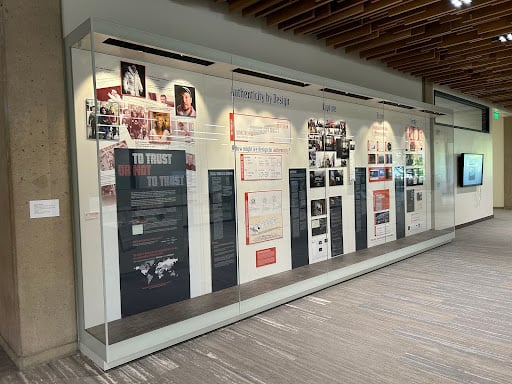Have you ever seen the Pope in a puffer jacket? Glancing at the image, I fully believed that the Pope had simply elevated his style…until I read the CBS headline next to the image which read, “Fake photos of Pope Francis in a puffer jacket go viral.”
“To Trust or not to Trust: Authenticity in Design,” curated by Stanford’s Starling Lab for Data Integrity, is currently on view on the first floor of Green Library. The display includes the aforementioned image of the Pope, included amongst other icons such as Taylor Swift and the British Royal family.
Focusing on authenticity of images and storage of data, the display seems geared towards the aesthetic of computer geeks — but the content is comprehensible even for those who have never taken CS106A.
The exhibition begins with an alarming declaration of the stake authenticity holds in democracy, including the fact that 60 countries are hosting elections within the next year, impacting more than 4 billion people. If these numbers seem too big to truly quantify, a quote by Nobel Laureate Maria Ressa included within the exhibition puts it more simply: “We will know whether democracy lives or dies by the end of 2024.”
Once the viewer is adequately uncomfortable and decently concerned, though, the display launches into an explanation of “Tech, Tools, & Terms” to ease some of that confusion. The exhibition panel includes highlighted terms which may be unclear in red and definitions at the bottom in a “Key Terms” section.
The two aspects of authenticity, as defined by the display, include identity and integrity. In order to highlight the value of both of these, the display largely focuses on photojournalism, using as examples photos from Ukraine and a Rolling Stone article made in collaboration with Starling Labs, “The DJ and the War Crimes.”
Though the goal of the exhibit seems to be to serve as an archive of sorts for what progression in the field of authenticating images has looked like and might look like going forward, it is largely up to the viewer to interpret whether to trust or not to trust.
“To Trust or Not to Trust” provides unedited photos, timestamps for when photos were taken and maps of where they were taken; in fact, the exhibit provides so much information that it might send many viewers into overdrive as they take it all in. (Maybe it’s the cynic in me, but the information it doesn’t provide might be the most relevant.)
The CBS headline featured in the exhibit has a quote from author Chrissy Tiegen that addresses the crux of the issue perfectly: “I thought the pope’s puffer jacket was real and didn’t give it a second thought. No way am I surviving the future of technology.”
Undeniably, journalists should be fact-checking themselves, as well as sources that seem unbelievable or implausible. But, how often does the average consumer of information go behind the scenes and check out the history of a photo they see or an article they read?
An international relations expert, a politician’s running for office and even most of today’s celebrities going about their day would care very much about origins of images featuring them — after all, wouldn’t you be a bit upset if your image was used to endorse a cause you disagree with? But, any person consuming media may have enough going on in their life that taking the extra few minutes to fact-check an image would feel like too much effort.
Despite the fact that I wish there was more focus placed on how many people already care about information authenticity, Starling Lab’s display itself is an attempt towards a “solution” in its own right. In demonstrating how much information is needed to truly authenticate images and information, they are inherently making viewers more aware of the value of doing so.
Though the wall display is not the only thing that Starling Labs curated for Hohbach Hall, it certainly steals the show. Although, I will admit, that might be because as someone who grew up around USB sticks, CDs and DVDs, there’s something a little disconcerting about reading about them in a museum case like a historical object.
This exhibit is definitely worth checking out. In honesty, I don’t have strong computer science skills — unless you need someone to help you with “Hello, World!” I won’t be much help to you. Despite this, though, the display was technical enough that I understood the mechanics behind what Starling Labs and other researchers are trying to achieve, yet also accessible enough that the information was not intimidating.
The final part of “To Trust or Not to Trust” looked towards the future by looking at what we’ve stored. Information storage — largely alluded to as the ambiguous “cloud”— needs a physical place to be held, and often information is lost to outdated systems or links that go bad, they implied.
Despite being inherently technological, the technology-themed exhibit only reinforced the importance of physical spaces to store knowledge, like our very own Green Library and similar libraries. After all, for all the complaining Stanford students do about West Stacks being a terrible study spot, they won’t become inaccessible from one day to the next just because a link becomes outdated, or because we lose a USB stick.
Editor’s Note: This article is a review and includes subjective thoughts, opinions and critiques.
